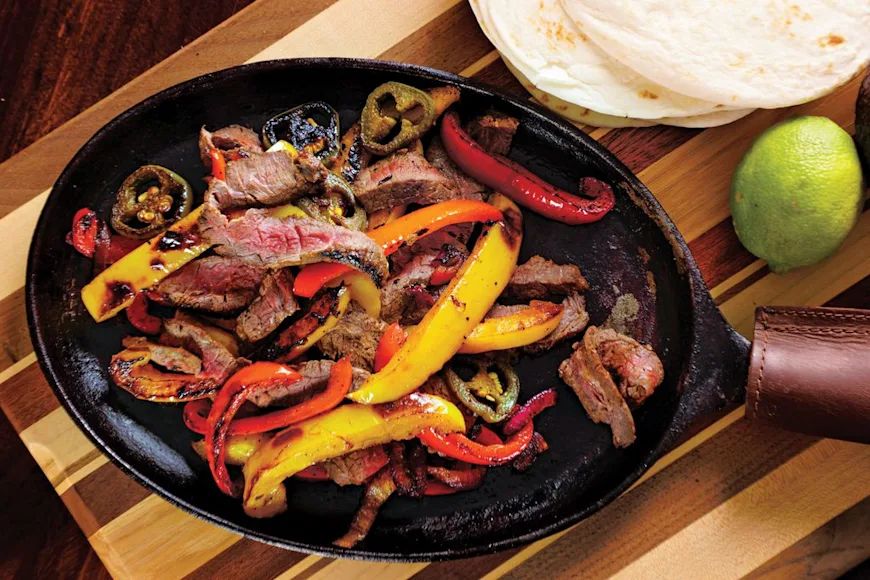While my Wyoming elk tag has so far gone unfilled, my friend Tess was luckier, tagging her first elk in a Nebraska cornfield not long ago. A heat wave prompted us to spend all day Sunday butchering and last night we put about 20 lbs. of trimmings through the grinder.
I’ve been processing my own (and others) deer and elk for about a dozen years and view adding some type of fat to ground venison as a necessary evil. I prefer ground pork, adding anywhere from 10 to 20 percent. Due to a calculating error on my part (I was told there would be no math!), Tess’ grind ended up at about 25 percent pork, a bit more than she preferred.
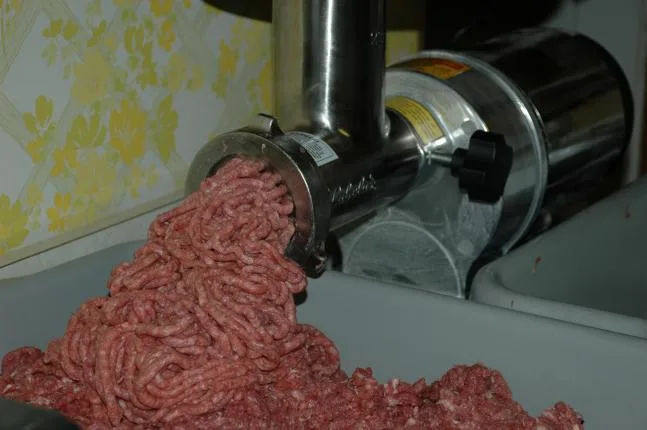
You don’t need to add fat to your ground game meat to make it taste good. Field & Stream Online Editors
This math problem set me to wondering why hunters take a healthy source of protein and fatten it up? That’s like someone on a diet taking a carrot stick and dipping it in ranch dressing. Quick research shows no clear consensus on what or how much fat to add. Some hunters swear by 50/50, others just 10 percent. Some like pork, others beef tallow. Some add bacon ends and pieces.
Certainly, there’s a rationale to adding fat, including enhancing flavor because, hey, we all know fat tastes good. Fat also keeps meat from drying out when you fry it and helps patties from falling apart. But is there a better, healthier alternative? Yes, depending on how you’re planning to cook it.
Cook Ground Venison, Elk, and Other Game Without Fat
Burgers on the grill are probably how much of the ground venison in America makes it to the table. I’ll be the first to admit, making a good burger without fat sounds impossible. The fat not only makes a burger juicy, it also helps it stay in patty form. Next time you have some 100 percent ground venison you want to throw on the grill, trying adding an egg and some breadcrumbs to serve as a binder. I’ve also heard of using steel-cut oats, diced onion, shredded potato and even powdered milk.
When frying ground venison for tacos, chili or spaghetti, cook it without fat. The spices should cover any gamy flavor you or your family might object to. (If not, find a new butcher to process your deer or learn to do it yourself. Since I started DIY processing 12 years ago, I’ve never had gamy game meat.) If the dry texture turns you off, try frying it in a little bit of olive oil, or add moisture as the venison browns in the form of stock, tomato juice or other flavored liquid.
Six Wild Game Recipes That Prove You Don’t Need to Add Fat
The rich, robust nature of wild game is the perfect complement to the vivid flavors found in the recipes of Mexico and the American Southwest. What’s more, the cooking techniques are tailor-made for turning tough cuts of antelope deer, elk, upland birds, and waterfowl into tender, tasty fare. With that said, here are six recipes that will turn taco night into a full-blown Tex-Mex fiesta. Just be sure to have some citrusy sodas and cold cervezas on hand to cool the fire.
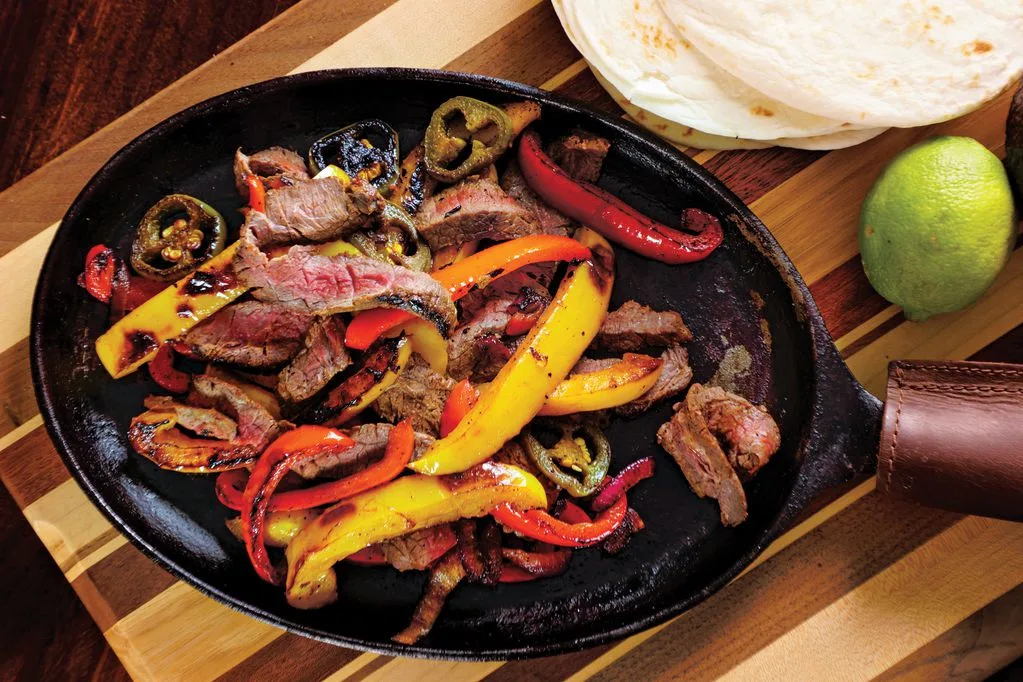
Add flavor and vegetables instead of fat to make sizzling elk fajitas.
Kickin’ Elk Fajitas
Add flavor and vegetables instead of fat to make sizzling elk fajitas.
With bright colors and rich aromas, these venison fajitas deliver a spicy blast to the senses—and that’s true even before you eat them. For this recipe, I prefer steaks cut from the flank or shoulder, which provide a bit more bite than a tender backstrap, but round steaks or sirloin work well, too.
Ingredients
2 elk steaks 1 red onion, sliced thin 2 bell peppers, seeded and sliced ¼ inch thick 1 jalapeño, seeded and sliced into rings Flour tortillas Queso fresco
For the Marinade:
1 cup orange juice ½ cup lime juice 1 Tbsp. Worcestershire 2–3 garlic cloves, minced 1 tsp. cumin 1 tsp. chili powder ½ tsp. kosher salt ¼ cup cilantro, chopped 4 Tbsp. canola oil (divided)
Kickin’ Elk Fajitas Directions
Place the elk steaks between two sheets of plastic wrap and pound them lightly with a meat tenderizer or rolling pin until they’re each about ½ inch thick. In a large bowl, mix the marinade ingredients, saving about half the cilantro for garnish. Whisk the marinade briskly while slowly drizzling in 2 Tbsp. of canola oil.
Put the sliced elk steaks in a gallon zip-top bag and pour in about half the marinade. Put the sliced onion and peppers in a second bag with the remaining marinade. Tightly seal both bags, removing as much air as possible, and then refrigerate for up to four hours. When ready to cook, remove the steak and peppers from the marinade, reserving the liquid from the vegetables.
Heat 2 Tbsp. of canola oil in a heavy skillet over medium-high heat. Sear the steaks until nicely browned on the exterior but still medium-rare in the center. Then, transfer the steaks to a cutting board and tent with foil. Add more oil to the skillet if little remains, then stir-fry the onions and peppers until they’re slightly softened and lightly charred. Next, glaze the skillet with a tablespoon or two of the reserved vegetable marinade, scraping up any browned food bits with a wooden spoon. Remove the skillet from the heat and set aside.
With a sharp knife, cut the steaks against the grain into ¼-inch-thick strips. Transfer them, as well as any juices that have accumulated on the cutting board, to the skillet with the vegetables, and then toss to combine. Serve with warm flour tortillas, crumbled queso fresco, and chopped cilantro. Serves 4
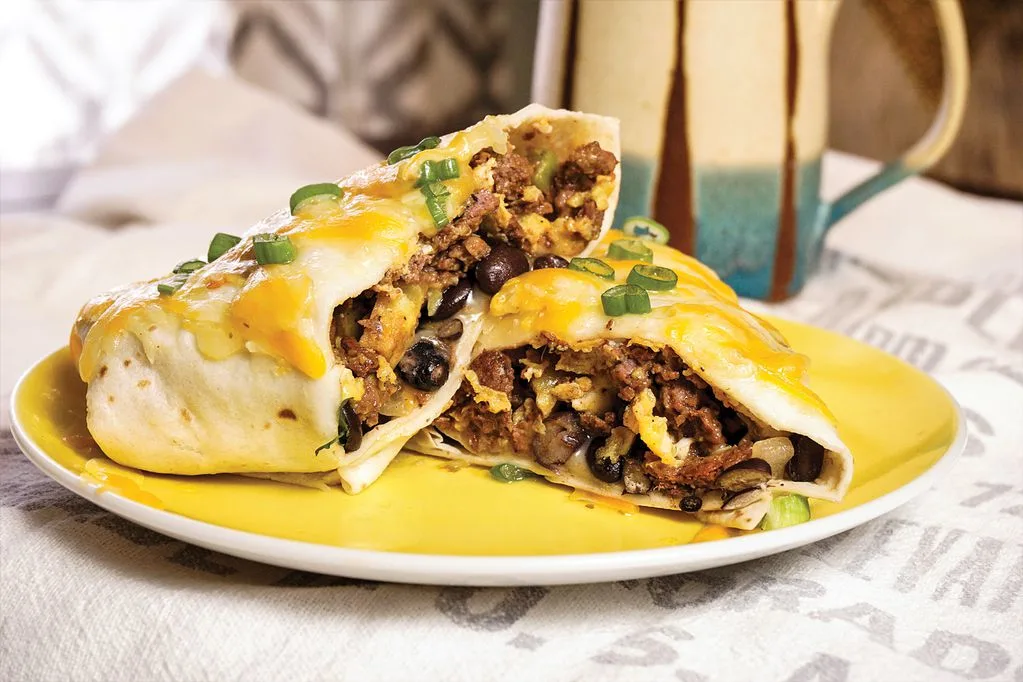
Venison Chorizo Breakfast Burritos
Adding chorizo to ground venison boosts the flavor without the need for beef fat.
Start your day with a giant burrito filled with spicy venison chorizo, and you’ll no doubt stay full, and warm, all morning. Not only that, when wrapped in foil and stashed in a pack, these burritos make a great midday meal in the deer stand or duck blind.
Ingredients
½ pound venison chorizo 1 cup potatoes, diced 6 eggs, whisked Kosher salt Black pepper 2 Tbsp. bacon drippings 1 14½-oz. can of black beans ½ tsp. cumin ½ tsp. chili powder ¼ diced onion Cilantro, chopped Large flour tortillas Avocado, diced Chile verde Colby jack cheese, shredded
Venison Chorizo Breakfast Burrito Directions
Pour the beans into a small pot and season with cumin and chili powder. Add the onion and cilantro, then simmer over medium heat.
Meanwhile, heat the bacon drippings in a large cast-iron skillet over medium-high heat. As the grease starts to smoke, add the diced potatoes and a pinch of salt, and then cook, stirring occasionally. Add the chorizo once the potatoes start to brown. Then, once the chorizo begins to brown, use a spatula or wooden spoon to break the meat into small pieces, and incorporate it with the potatoes. Push the meat and potato mixture to one side of the skillet and lower the heat.
Once the skillet has cooled slightly, pour the whisked eggs into the empty side of the skillet. As the eggs start to set, pull them into the center of the pan, allowing them to run onto the bare skillet. Season the eggs with kosher salt and black pepper, then stir the eggs together with the chorizo and potatoes. Remove the skillet from the heat.
To assemble the burritos, warm a large flour tortilla on a skillet or in the microwave. Then, place a large spoonful of the chorizo, egg, and potato mixture into the center of the tortilla. Then, with a slotted spoon, add a healthy amount of black beans, and top with diced avocado and shredded cheese. Roll the burrito tightly, folding in the sides as you go.
Drizzle a spoonful of chile verde over the wrapped burrito, followed by a sprinkling of shredded cheese. Lastly, place the completed burrito under a low broiler for 30 seconds, or until the cheese has melted. Serves 4
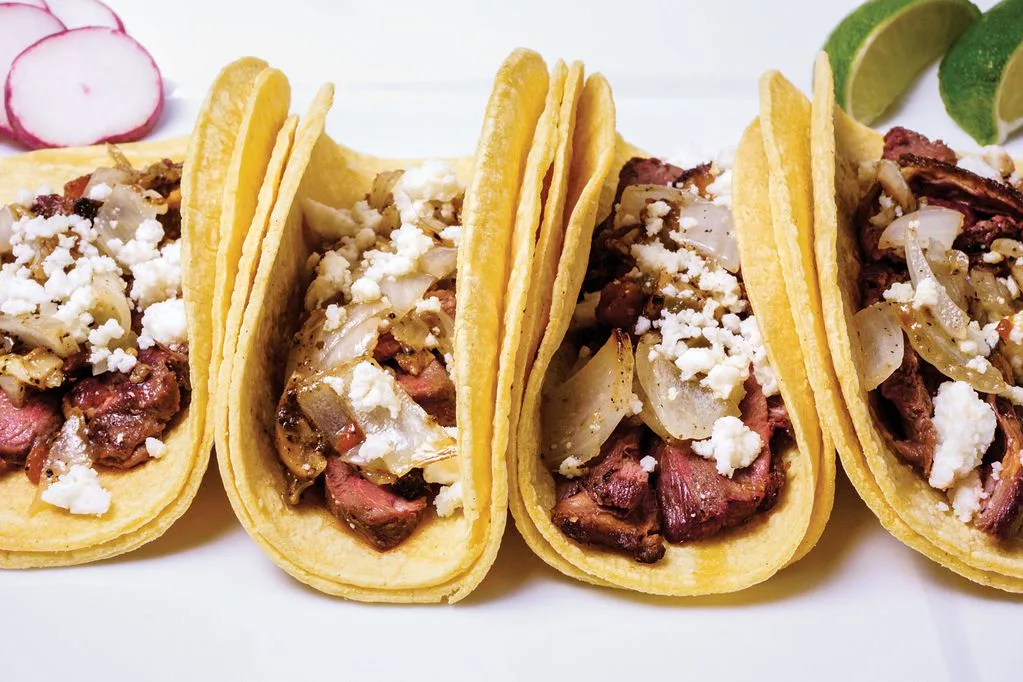
Grilled Duck Tacos With Mojo de Ajo
Tacos are always a great choice for sharing game meat with a lot of your friends––especially grilled duck tacos.
Allow me to brag for just a moment: These are the best damn duck tacos you will ever eat. Bold statement, I know. But it’s true. The rich flavor of a mallard breast grilled medium-rare and covered with soft white onion and pungent garlic chili oil will leave you reaching for another. And another. Better hope you have plenty of ducks in the freezer.
Ingredients
4 duck breasts, skin on 1 large white onion Kosher salt Mojo de Ajo (see below) Corn tortillas Queso fresco Garnish: pickled red onions, radish slices, lime wedges
For the Mojo de Ajo:
2 fresh Cayenne peppers ½ tsp. black peppercorns ½ tsp. dried Mexican oregano 1 cup olive oil 12–15 garlic cloves, smashed ½ cup diced tomato ¼ cup orange juice
Grilled Duck Tacos With Mojo de Ajo Directions
Prep the grill by lighting the coals, or preheat it to high. While the grill heats, make three to four diagonal slices through the duck skins, and cut the onion into thick slices. Brush both the duck and onion with oil from the mojo de ajo (directions below). Next, season the duck and onion with kosher salt, then let rest.
Once the grill is hot, wipe the grates with a paper towel soaked in vegetable oil. Then, set the duck, skin down, and onions on the grill and cook for 2–3 minutes. Flip and cook for another 2–3 minutes, or until the duck is medium-rare. Next, transfer the duck and onions to a cutting board and let rest for 5 minutes. Slice the duck and onions, then strain 2 Tbsp. of garlic from the mojo de ajo and drizzle over the onions.
Serve the duck and onions in warm tortillas and topped with queso fresco. Garnish with your choice of pickled red onions and sliced radishes, and a squeeze of lime juice. Serves 4
For the Mojo de Ajo:
Cut the stems from the chilies and remove the seeds. Toast the peppercorns and oregano in a skillet over medium heat just until fragrant, then transfer them to a spice grinder and process to a powder. Pour olive oil into a saucepan and add the garlic. Set over medium heat and cook, stirring until the garlic softens and turns light brown. Add the tomato and orange juice, along with the ground-pepper blend and diced peppers. Cook for another 2 minutes, and let cool before using.
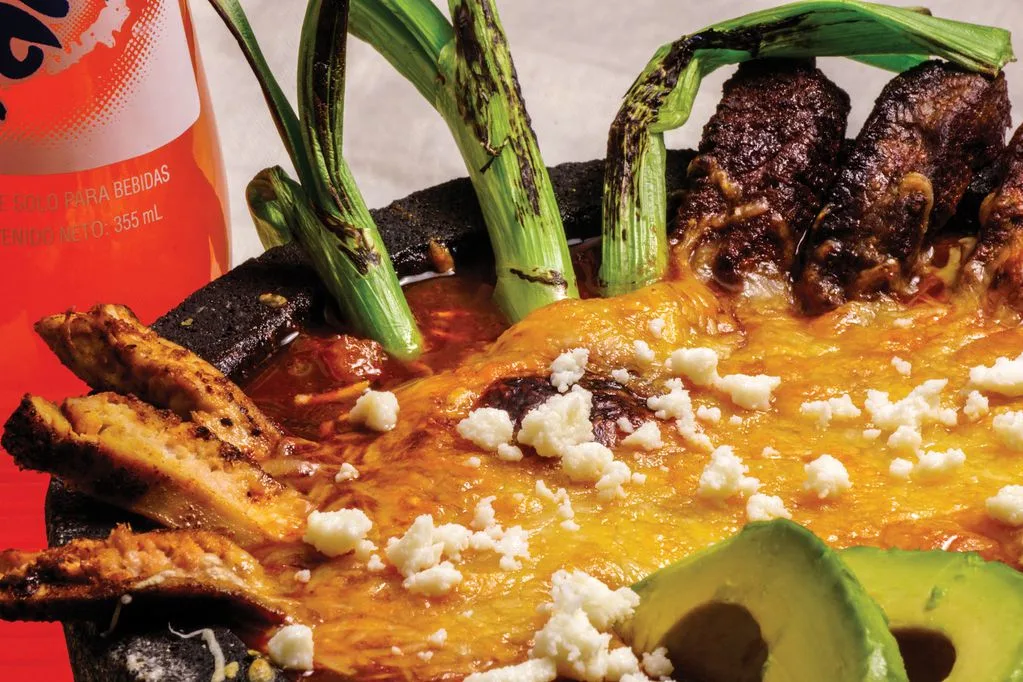
Mixed-Bag Molcajete
The Molcajete stone holds heat for a long time, making this an awesome party dish
Typically made from basalt, the molcajete is a versatile kitchen tool, used for everything from grinding spices to making guacamole. But there is no higher calling for the traditional Mexican mortar than a classic molcajete meat-and-chile bake. The stone holds heat for a long time, making this an awesome party dish.
Ingredients
1 venison steak 1 pheasant breast 3 green onions ¼ tsp. cumin ¼ tsp. chili powder ¼ tsp. ground coffee ¼ tsp. kosher salt
For the Chile Colorado:
3 Tbsp. shortening 2 Tbsp. flour ¼ cup red chile powder 1 cup chicken broth 1 cup water ½ tsp. cumin ½ tsp. garlic powder Kosher salt Sugar Colby jack cheese, shredded Garnish: avocado slices and crumbled queso fresco
Mixed-Bag Molcajete Directions
To make the Chile Colorado, melt the shortening in a heavy skillet over medium heat. Sprinkle in the flour and cook, stirring until the roux starts to brown, which should take about 5 minutes. Add the red chile powder and cook for a minute. Then, pour in the broth and water, along with the cumin and garlic powder, and stir until well blended and smooth. Add a pinch of salt and sugar to taste. Cover and simmer over low heat for 1 hour.
As the Chile Colorado simmers, prepare the venison steak and pheasant breast. Stir together the chili powder, coffee, cumin, and salt. Sprinkle the seasoning over both sides of the meat. Cook the meat over a hot grill until the steak is medium-rare and the pheasant breast is cooked through. Remove the meat from the grill and let rest. Slice the meat into thin strips, about ¼ inch thick.
Set the molcajete on a sheet pan and place it in a 350-degree oven for 20 minutes. Once the molcajete is hot, carefully remove it from the oven.
Put the venison and pheasant strips in the molcajete. Then, fill the bowl with Chile Colorado, add in the green onion, and cover with the shredded cheese. Return the full molcajete to the oven and bake for 15–20 minutes, or until the cheese is melted and bubbling.
Use oven mitts or hot pads to remove the hot molcajete from the oven. Garnish with avocado slices and crumbled queso fresco. Serve with fresh, warm tortillas. Serves 4–6
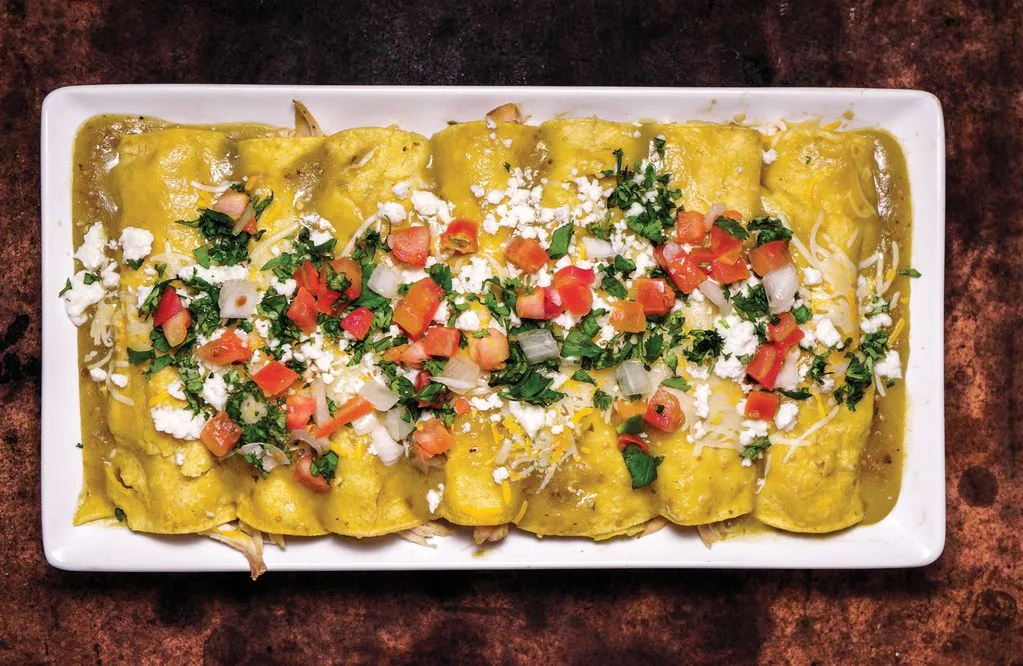
Pheasant Verde Enchiladas
Kick your enchiladas up a notch by replacing chicken with some fresh pheasant.
These enchiladas wing the Tex-Mex staple to the wild side by replacing humdrum chicken with pheasant breasts poached in a savory broth. This technique keeps the lean meat from drying out, and makes it easy to shred. Plus, the addition of a few Serrano peppers to the tangy tomatillo sauce adds a fiery bite.
Ingredients
2 bone-in pheasant breasts, skinned 1 onion, chopped 4 cloves garlic, smashed 6 cups chicken broth Black pepper 8–10 tomatillos 3 Serrano peppers ½ medium white onion 4 garlic cloves 1 tsp. cumin 1 tsp. kosher salt Reserved poaching liquid 2–3 Tbsp. masa harina 12 corn tortillas 2 cups Colby jack cheese Queso fresco, crumbled ¼ cup cilantro, chopped
Pheasant Verde Enchiladas Directions
In a large pot, combine the onion, garlic, and chicken broth, along with salt and pepper to taste. Set the pot over medium-high heat and bring the liquid just to the boiling point. Add the pheasant breasts, ensuring that they’re submerged, and cover the pot. Then, turn the heat off and let the pheasant breasts poach for 30–45 minutes, or until cooked through. Remove the pheasant from the poaching liquid and shred the meat from the bone with two forks. Strain and reserve the poaching liquid, discarding the solids.
While the pheasant is poaching, remove the papery skins of the tomatillos, and deseed the Serrano peppers. Place the garlic, onion, peppers, and tomatillos under a broiler until the tomatillos have softened and the peppers are charred in spots. Place the roasted vegetables in a blender with any accumulated juices, two cups of the reserved poaching liquid, and the cumin and salt. Puree until well blended.
Transfer the sauce to a skillet set over medium-low heat. Whisk together 2–3 Tbsp. of masa harina and ¼ cup of the cooled poaching liquid, then stir the combination into a sauce. Simmer until the sauce thickens, and then remove it from the heat and let it cool slightly before assembling the enchiladas.
To assemble the enchiladas:
Preheat the oven to 350 degrees. Place the shredded pheasant into a bowl and cover with about ½ cup of the sauce, adding more if necessary to adequately moisten the meat. Use a flexible spatula to spread a thin layer of the sauce in a casserole dish.
Wrap the tortillas in a moist tea towel and place them in the oven for 5 minutes to steam. Once the tortillas soften, dip them into the enchilada sauce, then fill them with the shredded pheasant and Colby jack cheese. Next, roll the tortillas around the fillings, and place the enchiladas seam side down in the casserole dish.
Once the casserole dish is full, pour the remaining sauce over the enchiladas, being sure to coat the ends of the tortillas. Cover the enchiladas with the remaining Colby jack cheese, and then transfer the dish to the hot oven. Bake for 15 minutes, or until the cheese is melted and the sauce is bubbling. Sprinkle queso fresco and chopped cilantro over the enchiladas and serve. Serves 4–6
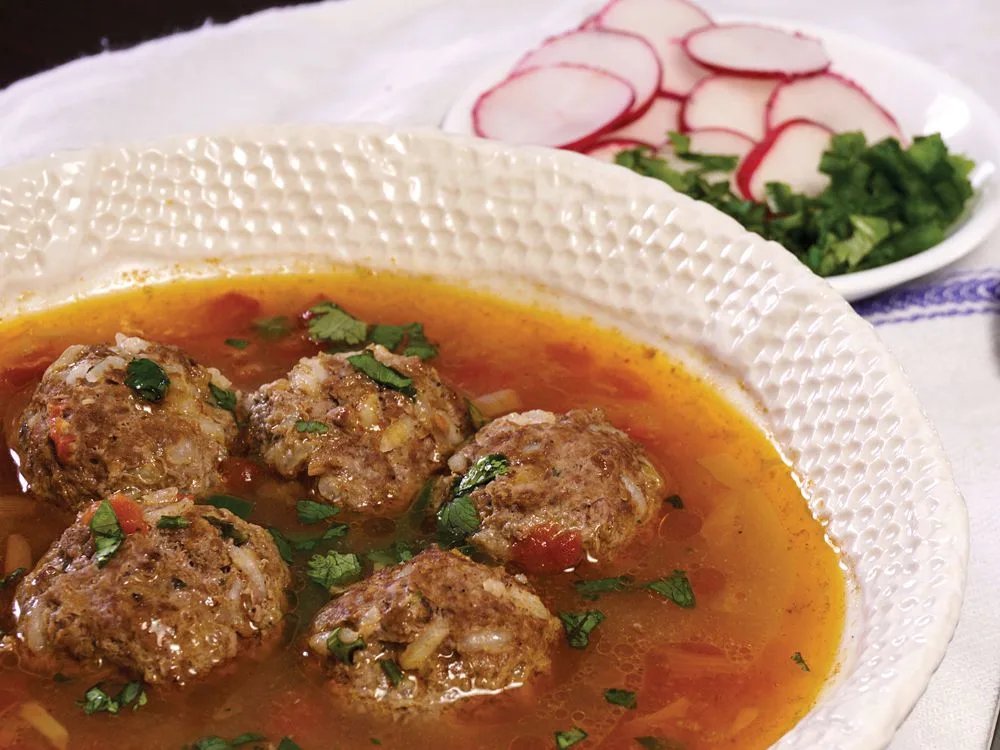
Antelope Albondigas
Albondigas are traditional Spanish meatballs served in a flavorful broth that keeps the meatballs from drying out.
There are many ways to make albondigas—traditional Spanish meatballs—but when using ground wild game, poaching is my go-to approach, for a flavorful broth keeps the meatballs from drying out. Deer, elk, or even ground waterfowl would work for this recipe, but I favor pronghorn antelope, which are prolific across the Southwest.
Ingredients
1 lb. ground venison or ground game ¼ cup cooked white rice 1 large egg, beaten 1 tsp. dried Mexican oregano ½ tsp. cumin ½ tsp. coriander ½ tsp. cayenne 1 tsp. kosher salt ½ tsp. white pepper Pinch of cinnamon Breadcrumbs, as needed 2 quarts chicken stock 1 tsp. avocado oil 1 carrot, diced ½ diced onion 1 cup diced tomatoes ¼ cup cilantro, chopped Black peppers to taste
Antelope Albondigas Directions
Place the ground antelope and rice in a large bowl, then add the whisked egg and spices. Using your hands, mix the ingredients until they’re well incorporated. If the meat mixture is really moist, add breadcrumbs a little bit at a time until it comes together but isn’t super dry. Next, roll the meat into spheres just smaller than golf balls and place them on a sheet pan. Once all the meat has been balled, refrigerate the meatballs for 30 minutes.
As the meatballs chill, heat the avocado oil in a large pot over medium heat, then sauté the onion and diced carrots until they’ve just softened. Add the chicken stock, tomatoes, cilantro, and all other remaining ingredients. Simmer for 30 minutes.
Remove the meatballs from the refrigerator and add them, a few at a time, to the simmering broth. Continue simmering for 20–25 minutes, or until the meatballs are cooked through.
To serve, add a few meatballs to a bowl, ladle broth over, and enjoy. Serves 4

